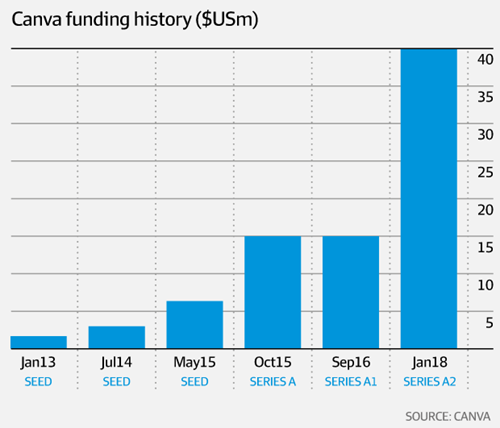From A Home-Grown Company to the World’s Latest Tech Unicorn
There was a theme of female empowerment that dominated Sunday’s Golden Globe Awards  and it has made me believe even more than before that 2018 will be the year we see the Empowerment of Women. As a woman in tech, my eyes shone even brighter when I saw the news about Melanie Perkins, the founder and CEO of Canva as she became the youngest female entrepreneur to have reached unicorn status.
and it has made me believe even more than before that 2018 will be the year we see the Empowerment of Women. As a woman in tech, my eyes shone even brighter when I saw the news about Melanie Perkins, the founder and CEO of Canva as she became the youngest female entrepreneur to have reached unicorn status.
Canva, the Australian provider of graphic design software as a service for those who aren’t graphic designers but want to create visual assets on the fly, put its own wings on as it has become the world’s latest and Australia’s second unicorn by raising $40 million in its latest funding round led by Sequoia China while previous investors Blackbird Ventures and Felicis Ventures also participated in the funding. The company is now valued at $1 billion.
Launched in 2013, Canva was founded by Melanie Perkins at age 24, who by the way, has no experience in the field whatsoever, with friends Cliff Obrecht (left) and Cam Adams (right). Initially, they developed an online design tool named Fusion Books for students and teachers to create their own yearbooks. From there, the platform has been expanded and become a graphic design as a service platform. Nothing comes easy so Perkins too, had her struggle early on but at the end of the day, success is often a product of failure. “A lot of trials and tribulations. A lot of time pitching in San Francisco, trying to get investors on board. Trying to get people to join my team. I had a lot of rejection along the way,” she recalls. “I think it was three years between meeting the first investor and actually landing the investment.”
Initially, they developed an online design tool named Fusion Books for students and teachers to create their own yearbooks. From there, the platform has been expanded and become a graphic design as a service platform. Nothing comes easy so Perkins too, had her struggle early on but at the end of the day, success is often a product of failure. “A lot of trials and tribulations. A lot of time pitching in San Francisco, trying to get investors on board. Trying to get people to join my team. I had a lot of rejection along the way,” she recalls. “I think it was three years between meeting the first investor and actually landing the investment.”
She shares her struggles from the early days of the company: "Years ago, I spent six months in San Francisco in two three-month blocks, as my visa expired, pitching every investor under the sun, going to every conference I possibly could and try to get people to believe in this crazy big goal that we had, which was that we could try and storm the world of design and make everything simple and accessible for everyone."
In 2015, Canva for Work was launched in an effort to enable a collaborative tool for any size of business that wanted to easily create visual marketing materials from business cards to brochures. In a short span of time, the company expanded its footprint outside Australia and went global. Today, as one of the fastest growing software businesses of all time, it is now available in 190 countries, 100 languages, and works with all operating systems.

As the Australian Securities and Investment Commission unveiled, Canva tripled its revenue to A$23.5 million ($18 million) and narrowed after-tax losses to A$3.3 million in the 12 months ending June 2017. Shortly after, Canva reached profitability and scored 294,000 paying customers for its platform. According to the company, which now has 250 staffers across its Sydney HQ and a branch office in Manila, more than 13 designs are created on Canva every second, and 80% of Fortune 500 companies have used the platform at some point.
When it comes to its pricing model, Canva offers several packages. For collaborating on the platforms, groups can pay either $12.95 per month or a reduced $9.95 per month for a one-time annual subscription. The end-product can be saved in another folder outside the platform and used on social media and such. Another offering Canva has, which I personally have used many times as well, is that its users pay only $1 to use more sophisticated designs illustrated in its marketplace. That way, the licensing issue would be taken off the table.
Canva's Product Roadmap
Following software giant Atlassian, Australia’s first tech unicorn which is now worth $11 billion, the newest kid on the local unicorn block, Canva aims to get 3.2 billion internet users on its platform. Speaking of the future, the company has raised $39 million to date, and its previous two rounds of funding, which hasn’t been spent yet, will be utilized for product development. The first step in the product development roadmap is making a significant enhancement to Canva’s presentation toolsets, which have been used to create 30 million presentations so far.
Perkins believes that while many people use PowerPoint, the product was designed before the internet era. Keeping this interest and gap in mind, she plans to revamp the presentation capabilities to provide people who have been using Microsoft products with the power of Adobe products as she realized how much people struggle even to learn the basic of programs like Adobe Photoshop and InDesign when she was at university.
Why Is The Design Market So Lucrative?
With a $91.2 billion valuation, Adobe is an 800-pound gorilla in the market. I mean, Adobe Creative Cloud alone has more than 7 million subscribers. According to Adobe, over 90% of the world’s creative professionals use Adobe, with Creative Cloud representing more than 50 percent of the company’s value. Alongside Canva, there are some other vendors like InVision that provide graphic design tools for people who don’t have any experience with Adobe’s suite of design products or are looking for easier and faster ways of creating their visual assets.
There have never been more people creating content. Especially, as a result of the ever-increasing trend in creating more visual-heavy content than text-heavy content, whether it’s creative professionals, photographers, students or hobbyists creating compelling images, videos, websites, or mobile applications, there is a huge demand for graphic design tools.
What makes the design market huge and lucrative is the switch from traditional product strategy to a more integrated cognitive approach such as design thinking. Today, the visual elements of web design can make or break businesses. To put this into perspective, let me tell the story behind the resilience of Airbnb.
In 2009, Airbnb was about to announce its bankruptcy as the company was making only $200  per week. Today, the organization is disrupting the tourism industry. Do you know what transformed Airbnb from a failing startup to a billion-dollar business? Yes, design thinking!
per week. Today, the organization is disrupting the tourism industry. Do you know what transformed Airbnb from a failing startup to a billion-dollar business? Yes, design thinking!
Following the “Silicon Valley mentality”, the organization had initially limited itself to the belief dictating that everything they did had to be ‘scalable.’ The postings, on the other hand, were not performing well at all and after spending a good deal of time understanding the underlying reason, the team figured out that the photos were too poor thus visitors were not attracted enough to book rooms. As an exact opposition to the initial mindset of the organization, Paul Graham came up with a non-scalable and non-technical solution to the problem: taking a trip to New York to spend some time with listed properties and take high-resolution captivating photos of them. As a result, a week later, upgrading the pictures resulted in doubled weekly revenue, $400 per week. From there, the organization built a ground rule saying that every newbie in the organization will be sent for a free trip in their first or second week in the company. In return, the employees will share back their answers to the structured questions as well as their comments with the entire company. That being said, neither only design nor face-to-face meetings with their customers played a huge role but simply providing consumers with a product that they needed for its value.
“If we were working on a medical device, we would go out into the world. We would go talk with all of the stakeholders, all of the users of that product, doctors, nurses, patients and then we would have that epiphany moment where we would lay down in the bed in the hospital. We'd have the device applied to us, and we would sit there and feel exactly what it felt like to be the patient, and it was in that moment where you start to go aha, that's really uncomfortable. There's probably a better way to do this,” said co-founder, Joe Gebbia.
My POV
As with many of you, the startup stories, either of success or failure, have always been of great interest to me as we learn a lot from their founders’ brave and inspiring paths. There are highs and lows in anything, so of course, it is expected to face lots of challenges along the way. However, what makes me excited the most in these stories, is to also see some entrepreneurs who make positive differences as they are shaping the tech industry, instead of getting caught up in very impressive income figures. In the case of Canva, what I really liked about the organization is the fact that they have given away free access to premium features to 17,000 non-profit organizations. Considering nonprofits typically are under-resourced and with tight marketing budgets, this type of incentive enables them to attain more visibility to spread their meaningful and inspirational core missions.
Another important aspect of the story is that Canva’s success is another indicator that a startup outside Silicon Valley, even the US, can pursue something they are passionate about and the likelihood of being successful is not a fairy tale. “Showing that it is possible to create a globally competitive company from Australia is awesome,” said Perkins in an interview. She believes that her story will pave the way for other startups. I definitely agree as the path has already begun being paved by Atlassian’s successes, and now with Canva setting a similar example, Australia’s largest city, Sydney, which has become the country’s principle tech hub in recent years, has once again come under the spotlight. As a matter of fact, in November, the government welcomed Mastercard to a new Sydney campus, which will provide workspace for its 560 local members of staff and an innovation hub.

Venus Tamturk
Venus is the Media Reporter for CMS-Connected, with one of her tasks to write thorough articles by creating the most up-to-date and engaging content using B2B digital marketing. She enjoys increasing brand equity and conversion through the strategic use of social media channels and integrated media marketing plans.